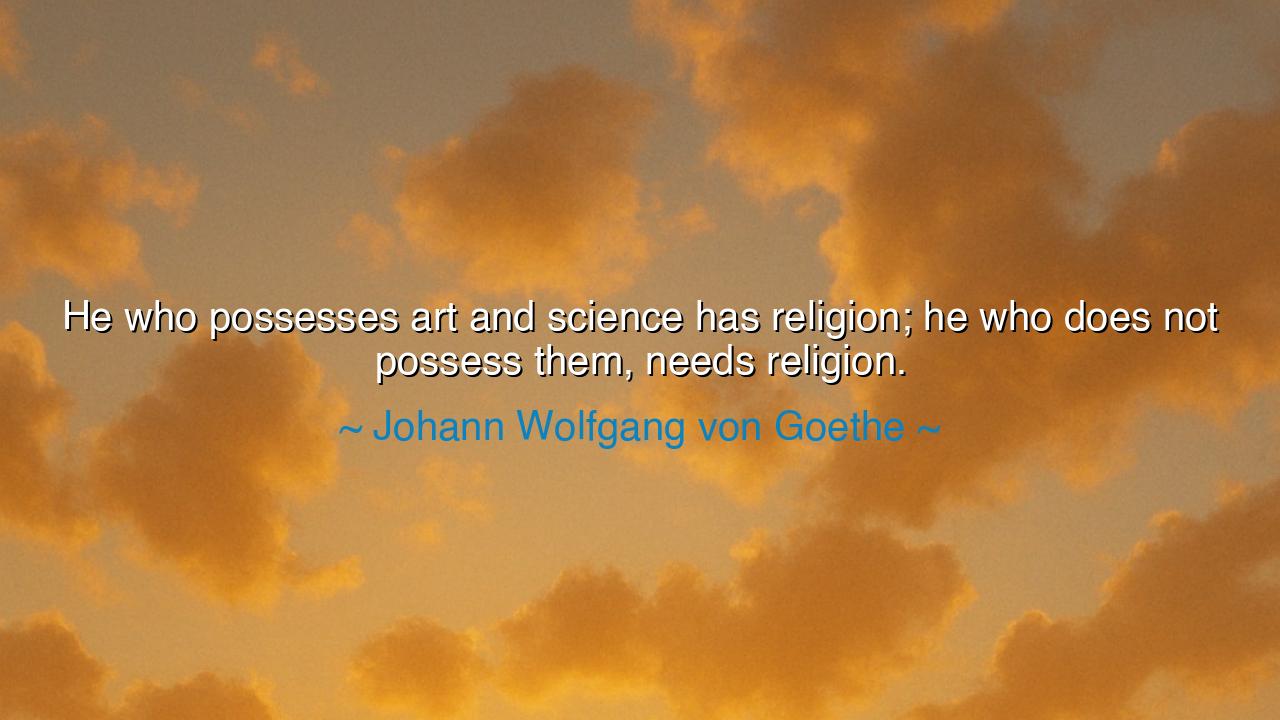
He who possesses art and science has religion; he who does not
He who possesses art and science has religion; he who does not possess them, needs religion.






"He who possesses art and science has religion; he who does not possess them, needs religion." These profound words by Johann Wolfgang von Goethe speak to the deep interconnection between knowledge, creativity, and spirituality. Goethe, a towering figure of the German Enlightenment, recognized that true religion is not merely a set of doctrines or rituals, but a living, breathing force that can be experienced and understood through the pursuit of art and science. To him, art and science were the vehicles by which the human spirit could soar to the divine, transcending the boundaries of ordinary existence. Thus, those who engage deeply with these pursuits possess, in some sense, an innate religion, an understanding of the divine that is expressed through creation, discovery, and the unification of knowledge.
In the ancient world, the connection between art, science, and spirituality was often inseparable. The Greeks, particularly those of the Hellenistic period, believed in the harmony between the arts and natural philosophy (what we now call science). Plato saw the pursuit of beauty through art and the search for truth through philosophy as intertwined paths leading to a deeper understanding of the divine. For him, both art and science were means of engaging with the higher forms of existence, leading the soul closer to the One, the ultimate source of truth and goodness. Just as Goethe suggests, Plato’s belief was that the pursuit of art and science could bring a person closer to the divine, offering a form of religion that transcended the conventional structures of worship.
Consider the life of Leonardo da Vinci, whose genius bridged the realms of art and science. Da Vinci’s work exemplified Goethe’s insight: he did not see art as separate from science, but as deeply connected to it. His paintings, such as the Mona Lisa, are renowned for their stunning beauty, but they also demonstrate his knowledge of anatomy, light, and mathematics. Leonardo’s artistic creations were a reflection of his understanding of the natural world, while his scientific studies were infused with the same sense of creativity and awe. For Leonardo, art and science were the tools through which he touched the divine, making him, in Goethe’s view, a man who possessed religion in its most profound form—through the union of knowledge and creativity.
In contrast, we look to the common people of the ancient world, who, without the benefits of education or access to the arts, found their spiritual fulfillment through more traditional forms of religion. The great mystery religions of the time, such as Isis and Mithras, flourished as a response to the deep yearning for meaning that could not always be satisfied by philosophy or science. Religion provided them with answers to the great questions of existence—why we live, why we suffer, and what comes after death. Without the intellectual tools of philosophy or the creative expression found in art, many people turned to faith as a means of filling the void. Goethe’s observation holds here: those without the tools of art and science are often drawn to religion for comfort and understanding.
Yet, Goethe was not dismissing the importance of religion in this quote. Rather, he was emphasizing that the deepest religious experiences can often be found not in traditional worship or doctrine, but in the acts of creation and discovery. Art and science are not mere tools for worldly success, but sacred pursuits that allow us to engage with the mysteries of the universe. The divine can be felt in the brushstroke of a painting, in the equation of a scientific formula, or in the beauty of the natural world uncovered by science. To create is to engage with the divine in a deeply personal way, and to discover is to unlock the secrets of the universe that are woven into the fabric of existence itself.
The lesson from Goethe’s words is one of integration—the understanding that art and science are not merely separate, but interconnected aspects of the same quest for truth and meaning. If we seek to understand the world in its fullest sense, we must embrace both the rational and the creative. We are called not only to think critically but also to create, to express, and to engage with the world through our senses and imagination. Religion, in its purest form, transcends dogma and becomes an experience of the sacred that is felt in every act of creation and discovery.
In practical terms, we can apply this teaching by engaging with the world in a way that nourishes both our intellect and creativity. Whether through the pursuit of science, the creation of art, or the cultivation of a deeper spiritual life, we must strive to balance reason and imagination, the material and the divine. Let us find ways to infuse our daily lives with both knowledge and creativity, knowing that in doing so, we are not only enhancing our understanding of the world, but also participating in the divine mystery that is present in every aspect of existence.






AAdministratorAdministrator
Welcome, honored guests. Please leave a comment, we will respond soon